The shallot is a small onion of the multiplier type. Its bulbs have a more delicate flavor than most onions.
Shallots are cool-weather vegetables usually. They are usually planted in spring and autumn.
Shallots can be grown from seeds or sets (small shallots). Sets can be planted in the garden 2 to 4 weeks before the last frost in spring. Seeds can be sown indoors 4 to 6 weeks before transplanting seedlings to the garden after the last frost in spring.
Related articles:
- Tasty Ways to Cook and Serve Shallots
- Onion Cooking and Serving Tips
- Planting Onions Seeds and Sets
- Growing Onion Bulbs: Pick the Right Variety
- How to Grow Onion Sets
- How to Harvest and Store Onions
- How to Grow Green Onions
- How to Plant, Grow, and Harvest Welsh Onions
- Onion Family Growing Problems Troubleshooting
- How to Plant and Grow Onions
- How to Plant, Grow, and Harvest Shallots
Shallots mature in about 100 days, but they can be dug any time they reach a usable size. For storage shallots, wait to dig bulbs until the tops have withered.
A shallot set will yield 10 to 15 times as many mature shallots. Shallots are hardy and may be left in the ground from year to year, but the best results come from lifting the cluster of bulbs at the end of the growing season and replanting the smaller ones the next season.
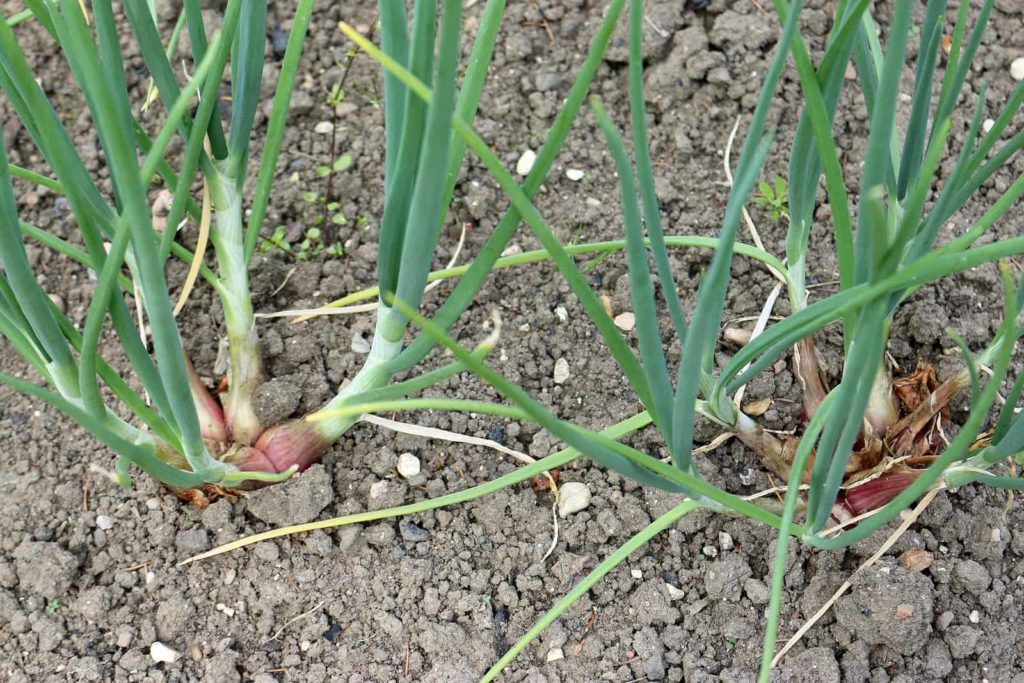
The shallot is a member of the onion family, a very hardy biennial grown as an annual. Shallots are not the same as scallions, green onions, or spring onions though these three members of the onion family are often eaten raw or cooked in similar ways.
Shallots grow to about 8 inches (20cm) tall in a clump with narrow green leaves and roots that look like small onions, about ½ inch (12mm) in diameter at maturity. Shallot bulbs grow in clusters much like garlic but instead of being held together by an enveloping membrane, they are attached at the base.
Tools for Vegetable Gardeners at Amazon:
- A.M. Leonard Straight Rake with Ash Handle
- All-Steel Nursery Spade with D-Grip Handle
- 4-Tine Spading Digging Fork with D-Handle
- Digital Soil pH Meter Outdoors Greenhouse
- Earthwise Handheld Electric Fertilizer Spreader
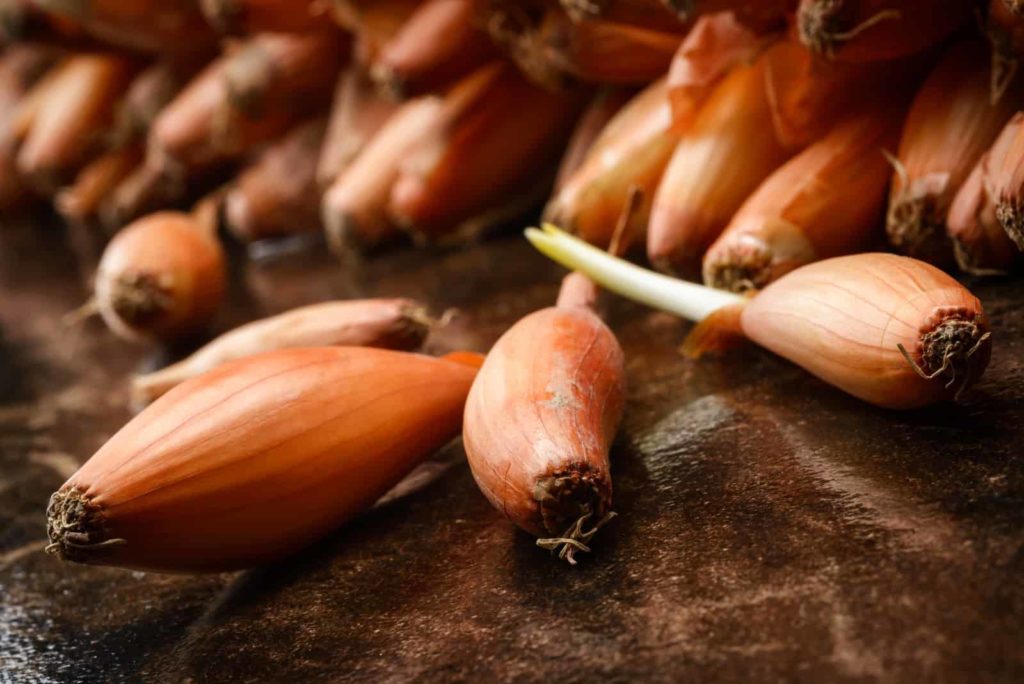
Shallots prefer humus-rich, well-drained soil. They need moderate amounts of phosphorus and potassium. The soil should be kept evenly moist while they are developing. Withhold water once the tops begin to yellow and dry.
Shallots can be left in the ground in mild-winter regions, but for the best quality and largest-sized bulbs, clumps should be harvested each year. Small to medium-sized bulbs can be set aside for replanting the following year.
Shallots add a distinctive, complex flavor to savory dishes. Young outer leaves can be used like chives. Shallots can be used in soups and stews, salads, and salad dressings. Young shallots can be harvested for use as green onions.
Types of shallots
There are five general types of shallots: Jersey, gray French, Dutch, and Persian.
- Jersey shallot (Allium cepa) from the Isle of Jersey can be either long or half-long types. Jersey shallots are mild flavored. These are commonly found in the grocery store.
- Gray French shallot (Allium oschaninii) or “true shallot” is chicken thigh shaped and is thus called Cuisse de poulet. It has a deep golden skin and is sharper flavored than Jersey shallots. French varieties rarely flower and set seed; they are grown from immature bulbs. They have a scar at the bottom of the bulb and few roots.
- Dutch shallot (Allium cepa var. aggregatum) is a more rounded large bulb–larger than the French shallot–with either yellow or coppery red skin. The flavor of the Dutch shallot is a bit sweeter than the French shallot. Dutch shallots are often grown from seed, unlike French shallots; they have many roots at the base of the bulb, similar to an onion. Dutch shallots are botanically a variety of onions; they were once classified as their own species, Allium ascalonicum.
- Persian shallot (Allium stipiatum) or Asian onion which has a smaller bulb than other shallots and often grows wild in western Asia.
- Hybrid shallots are crosses between French and Dutch shallots; cultivars include ‘Echalote Grise’, ‘Longor’, and ‘Pescandor.’
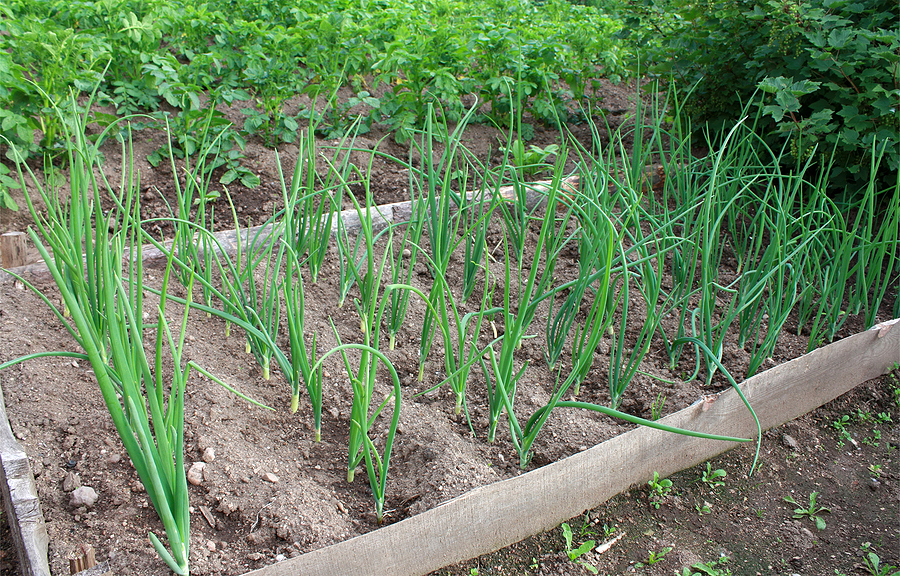
Shallots quick growing tips
Grow shallots from small bulbs called sets or from seeds. Space plants 2 inches apart to produce single bulbs, and 6 inches apart to produce multiple bulbs from each plant. Leave the tip of each bulb protruding just above the soil level. Protect shallot bulbs from birds by laying bird netting over the planting bed.
- Set cloves in the garden as early as 4 to 6 weeks before the average last frost date in spring.
- Shallots require a dormant period of about 30 days soon after planting with temperatures between 32° and 50°F (0-10°C).
- Shallots will grow in soil temperatures ranging from 35°F to 90°F (2-32°C).
- Shallots yield plant 4 to 6 shallots per household member.
- If you want to use shallots like green onions, sow seeds 2-3 inches apart and harvest the green tops as needed.
Shallots planting details
- Sowing depth: Sow seed ½ inch (1.2 cm); plant sets so that the pointed tip barely shows above the soil, not more than 1 inch deep.
- Space between plants after thinning: 4-6 inches (10-15cm)
- Days to sprout: 10-14
- Days to harvest: 100, but they can be dug any time they reach a usable size.
- Storage period: 12-32 weeks
- Seeds per 100-row feet: ½ ounce (14 grams)
- Yield per 100-row feet: 50 pounds (22 kg)
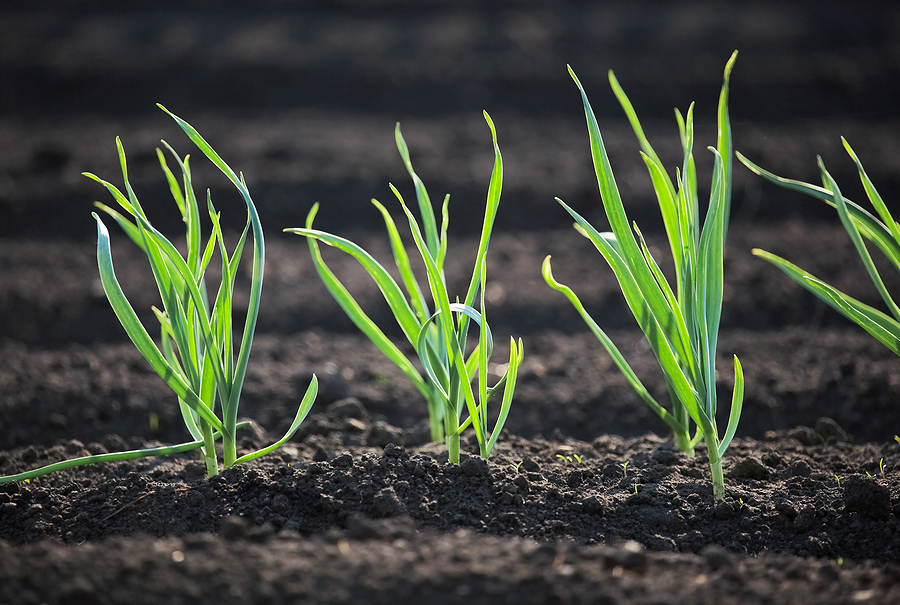
When to plant shallots
Plant shallots—like onions—early in the season. Leafy top growth which nourishes the bulbs comes during cool shorter days. Bulbs begin to form and grow during warmer long days later in the season.
If starting from seed, sow shallot seeds indoors 8 to 10 weeks before you want to set seedlings into the garden. Sow seeds in trays filled with seed starting mix. Set seed starting trays under fluorescent shop lights or in a sunny window. Keep the starting mix just moist; do not let it dry out. Seedlings can go into the garden just before the last frost when they are about 4 inches tall.
- In mild winter regions, plant shallots in late autumn or winter.
- In cool–but not cold–winter regions plant shallots in late summer and autumn for spring harvest. Plant them again in spring for fall or winter harvest.
- In cold winter regions plant shallots in the garden three weeks before the last spring frost or later.
Shallot planting dates
(These dates are for the Northern Hemisphere)
| Average date of the last frost | Planting dates |
| Jan. 20 | Jan. 1-Feb. 1 |
| Feb. 8 | Jan. 1-Feb. 10 |
| Feb. 18 | Jan. 1-Feb. 20 |
| Feb. 28 | Jan. 1-Mar. 1 |
| Mar. 10 | Jan. 15-Mar. 1 |
| Mar. 20 | Feb. 1-Mar. 10 |
| Mar. 30 | Feb. 15-Mar. 15 |
| Apr. 10 | Mar. 1-Apr. 1 |
| Apr. 20 | Mar. 15-Apr. 15 |
| Apr. 30 | Apr. 1-May 1 |
| May 10 | Apr. 10-May 1 |
| May 20 | Apr. 20-May 10 |
| May 30 | May 1-June 1 |
| June 10 | May 10-June 1 |
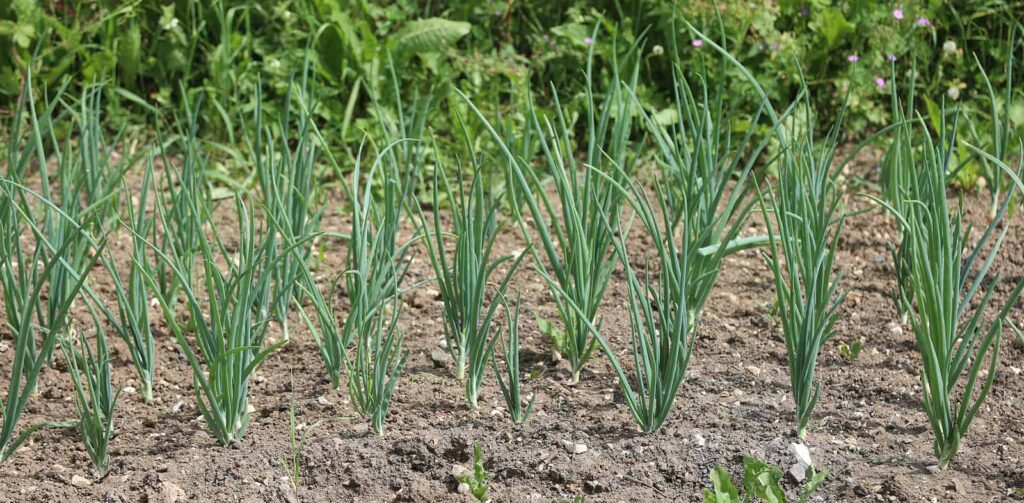
Where to plant shallots
Delicately flavored shallots grow best in slightly sandy, well-drained soil. Where the soil is even a bit heavy with clay, you will get the best results growing shallots in raised beds evenly amended with organic matter such as aged compost.
- Grow shallots in full sun; shallots will tolerate partial sun.
- The soft roots of shallots do not like compacted soil. Turn the soil at least 6 to 8 inches deep with a garden fork before setting out transplants. If the soil is heavy clay or filled with pebbles and stones, plant leeks and shallots in raised beds.
- Plant shallots in well-worked, well-drained, moisture-retentive, loose soil rich in organic matter.
- Prepare the soil surface to a fine tilth before planting shallots. Shallots have a shallow root system; prepare the soil about 6 inches deep.
- Work well-rotted garden compost or a complete, well-balanced organic fertilizer into the soil ahead of plants.
- Shallots prefer a soil pH of 5.0 to 6.8.
- Shallots will be less flavorful if grown in heavy soil, or clay soil.
- Where the soil is heavy with clay, grow shallows in raised beds rich in organic matter.
- Shallots have less flavor when grown in clay soils.
Growing shallots in a raised bed
Where you plan to grow shallots, enrich a raised or mounded bed with plenty of aged compost. Add two to three inches of compost into your raised bed twice a year; add compost 2 or 3 weeks before planting and again at the end of the season after harvest. You can also sprinkle a bulb booster or wood ash across the bed—adding phosphorus and potassium.
Rake the bed smooth and then set out parallel rows 8 inches apart for your shallot starts. Use your finger or a dibble to space planting holes 8 inches apart in the row. Each hole should be deep enough to just cover each bulb. Plant shallot bulbs pointed end up.
Shallots planting temperatures
Choose smaller “seed” shallots (and onions) for starting new plantings; they are less likely to bolt. Larger shallots will yield large clumps of small shallots. (Shallots are seldom grown from seed. They are commonly propagated using small cloves or divisions.)
- Shallots are usually grown from cloves (called shallot set) but sometimes (less often) from seeds.
- Set cloves in the garden as early as 2 to 4 weeks before the average last frost date in spring.
- Sow seeds indoors 8 to 10 weeks before the average last frost date. Seeds started indoors at room temperature (70°F ) will germinate in 10 to 14 days.
- The optimal air temperature for growing shallots is 55° to 75°F.
- Shallots will grow outdoors in soil temperatures ranging from 35°F to 90°F (2-32°C).
- Shallots started from cloves outdoors benefit from a dormant period of about 30 days soon after spring planting with temperatures between 32° and 50°F (0-10°C).
- Shallots are ready for harvest in 60 to 120 days depending on the variety.
- Plant shallots in spring in USDA Zones 2-5; plant shallots in fall in Zones 6-10.
- In mild winter regions, shallots can be planted in autumn for harvest from late winter to late spring.
Planting and spacing shallots
- Shallots are most often grown from cloves, but some species are grown from seed.
- Set shallot cloves pointed end up, broad end down.
- The top of the shallot should be even with the soil, only lightly covered at most.
- Sow seeds 1/4 to 1/2 inch deep.
- Space cloves 4 to 6 inches (10-15cm) apart or thin seedlings from 4 to 6 inches apart.
- Space shallots 6 inches apart in wide rows, intensive planting.
- Space rows 9 inches (23cm) apart.
- Shallot bulbs contain 3 to 4 cloves protected by a brown papery skin. Plant individual cloves.
- Replant any bulbs that work their way out of the soil.
- Shallot seedlings started indoors can be set in the garden about 8 weeks after germination when seedlings are about 5 to 6 inches tall.
Shallots companion plants
- Grow shallots with beets, lettuce, strawberries, summer savory, and tomatoes.
- Do not plant shallots with beans or peas.
Container growing shallots
- Shallots can be grown in an 8-inch (20cm) pot, plant 2 or 3 cloves in the pot.
- If the weather warms, move containers to a cool spot.
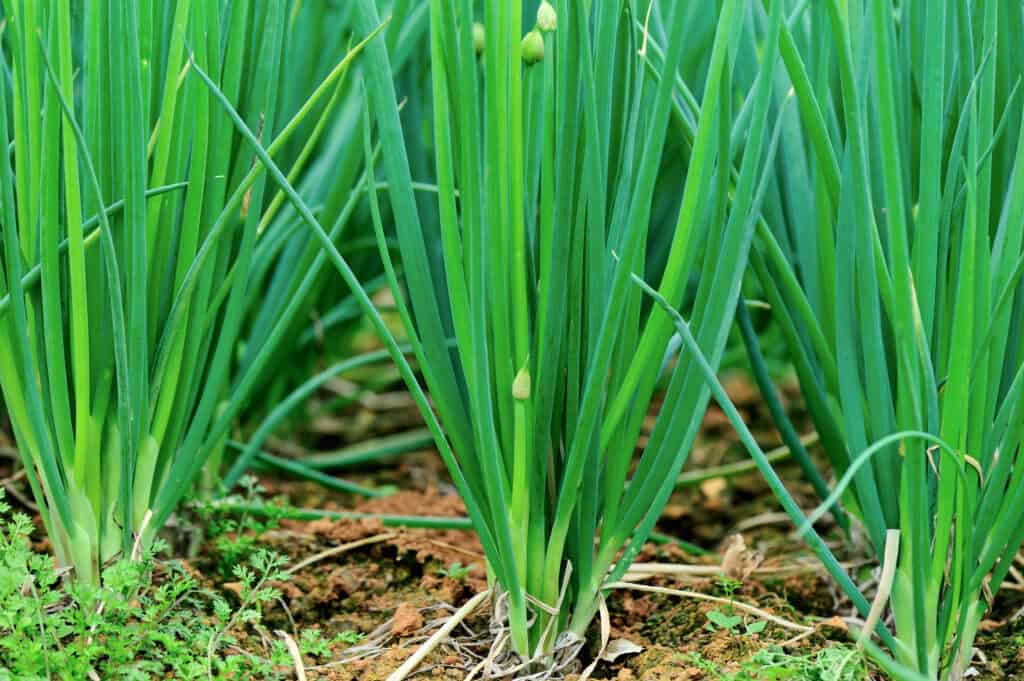
Watering shallots
Water in the newly set bulbs. The soil should be kept just moist during the growing season—not too wet, not too dry. Add about an inch of water across the bed each week—meaning enough water so that each square foot of the bed is moist to 1 inch deep. Your raised bed will allow for quick drainage; shallots do not like to sit in soggy soil. Be sure to water if it does not rain.
- Keep shallots evenly moist; do not allow the soil to dry out.
- Give shallots about one inch of water each week.
- Avoid soggy soil which can rot young plants.
- When the first frost is near, withhold water to quicken the withering of the top which in turn promoted the curing of bulb clusters.
Feeding shallots
Feed shallots every three to four weeks until about a month before harvest. Sidedress shallots with a liquid fertilizer such as compost tea or fish emulsion. If you add a rich layer of aged compost to the raised bed twice a year, side-dressing will not be necessary.
- Add aged compost to planting beds before planting.
- Feed shallots with an even organic fertilizer such as 5-5-5 at planting time or work the fertilizer into the soil before planting.
- Shallots can also be fertilized with bone meal or water-soluble seaweed or kelp powder.
- Side dress shallots with aged compost at midseason.
Shallot care
- Mulch around shallow after five to six shoots appear, about 3 to 4 weeks after planting.
- Mulch lightly with straw, chopped leaves, or aged compost being careful not to cover shoots.
- Keep weeds away from shallots; weeds compete for moisture and nutrients. Cultivate weeds carefully; shallots are shallow-rooted and should not be disturbed.
- Keep planting beds weed-free so that shallots do not compete for water and nutrients.
- Bend or “lodge” the stalks when they are 16 inches (40cm) tall or more; this will force shallots to mature in 3 to 4 weeks.
- Shallots clumps can be divided into multiple plants every year or two.
- Do not plant shallots where garlic bulbs have previously grown.
- Protect shallots that are overwintered in the garden with a thick straw mulch or chopped leaves.
Shallot pests
- Shallots have no serious pest problems.
- Thrips and onion maggots can occasionally be a problem.
- Onion thrips (Thrips tabaci) are tiny sap-sucking insects. Control thrips with need oil or insecticidal soap.
- Onion maggots (Delia antique) are small white maggots that tunnel into roots causing the leaves to turn brown and the plants to become stunted. Onion maggots are the larvae of a brown hovering fly. Exclude the flies from laying eggs by protecting young plants with row coves.
Shallot diseases
- Where the soil is well-drained, shallots generally have no serious disease problems.
- White rot and pink rot can affect shallots along with other alliums.
- White rot (Sclerotium cepivorum) is a fungal disease characterized by white mold-like growth on the leaves at the neck of the plant. It can not be cured. Rotate all onion-family crops out of the planting bed indefinitely.
- Pink rot (Phoma terrestris) is a fungal disease that may occur in waterlogged soil; roots turn pink; plants become stunted or turn brown. Plant in raised rows or raised beds to be sure the soil is well drained.
- Purple blotch (Alternaria porri) is a fungal disease that causes purple blotches on leaves. Control purple blotch with a copper-based fungicide and avoid overhead watering.
- Remove and destroy shallots infected with white rot and do not plant onion-family crops in the same sport for at least 5 years.
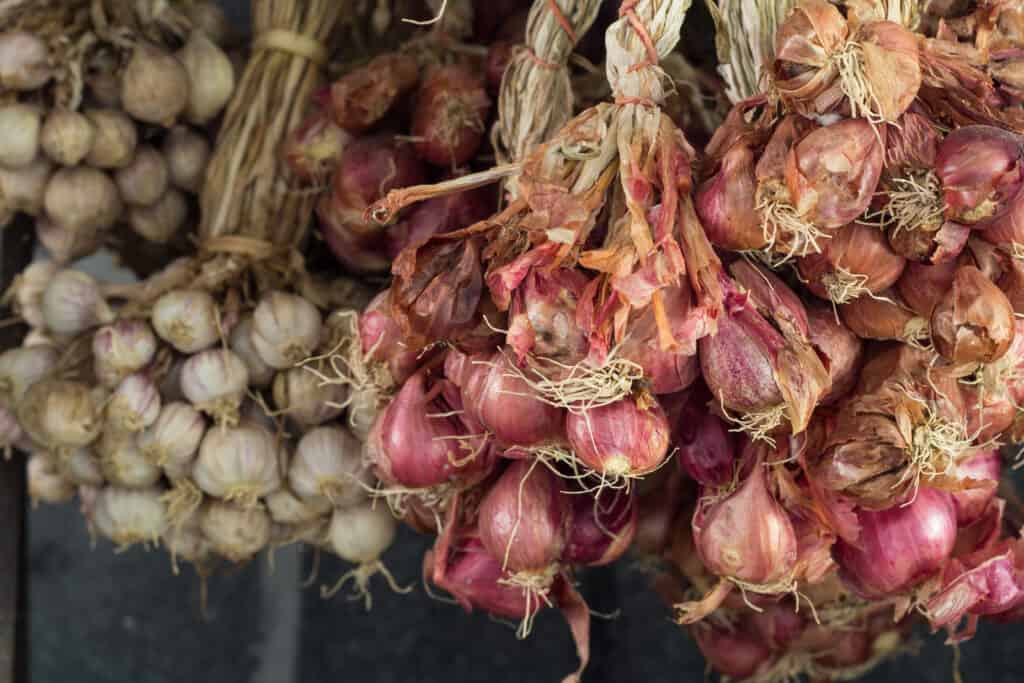
Harvesting shallots
Harvest shallots when the top three-quarters of the leafy growth dries and falls over. Harvest begins when the shallots’ green tops start to fall over and turn brown, about 90 to 120 days after cloves are set in the garden.
- Shallots are usually ready for harvest 100 to 120 days after planting, sometimes longer when planted in autumn in mild winter regions.
- Shallot bulbs are about a half inch in diameter when mature. The bulbs grow in a “nest” of 3 to 15 bulbs; they resemble a head of garlic cloves except there are fewer cloves and no outer covering, unlike garlic.
- Usually, 8 to 15 bulbs will grow for each shallow bulb you have planted.
- To harvest mature bulbs, wait until the leaves die back and turn yellow-brown; then pull up, lifting the bulbs out of the soil.
- Let the bulbs sun-dry for 2 to 3 days up to a week or more; then cut off the tops and store the bulbs as you would bulb onions or garlic in a dry place out of direct sunlight.
- Green shallot leaves can be cut throughout the growing season and used as a seasoning. Be careful not to cut away any new growth coming from the central stem.
- To use shallots as green onions, dig or pull clusters at any size.
Curing shallots
Set harvested bulbs in a warm, dry place to cure for about ten days before storing them.
Cure the shallot bulbs in a dry, warm place until the tops are completely dry. Space bulbs apart in a well-ventilated place so that rot does not set in. Shallots are cured when the tops are papery and crisp.
Trim the tops after drying. Store shallots in ventilated bags at about 40°F.
Storing and preserving shallots
- Shallot greens will keep in the refrigerator for up to one week. Greens can be chopped and frozen like chives.
- Store shallot bulbs like onions in a cold, dry place for up to 6 months.
- Shallot tops can be braided and shallots hung in a dry, shaded location or bulbs can be stored in mesh bags.
- Store shallots at 32° to 40°F in a dry place.
- Freeze or dry shallots like onions.
- Set some small-to-medium-sized bulbs aside for planting in spring.
Shallots in the kitchen
- Shallots can be sautéed, braised, grilled, or stir-fried. Shallots are a mild-flavored alternative to garlic.
- Shallots can be served raw or cooked–toasted, stewed, caramelized, and double-poached.
- Raw shallots have a pungent flavor similar to an onion. Cooked shallots are mild and sweet flavor.
- Shallots are commonly diced into small pieces for use as an aromatic in various dishes.
- Slice shallots thinly and brown in butter with a little chopped thyme till deeply caramelized, then serve as a topping for grilled chicken, liver, or hamburgers.
- Use small bulbs in the classic French beet stew, boeuf bourguignon.
- The greens of immature shallots can be chopped and used like chives.
- Stir chopped shallot leaves into sour cream as a dressing for vegetables or fish.
- Shallots can be diced and lightly added to salads.
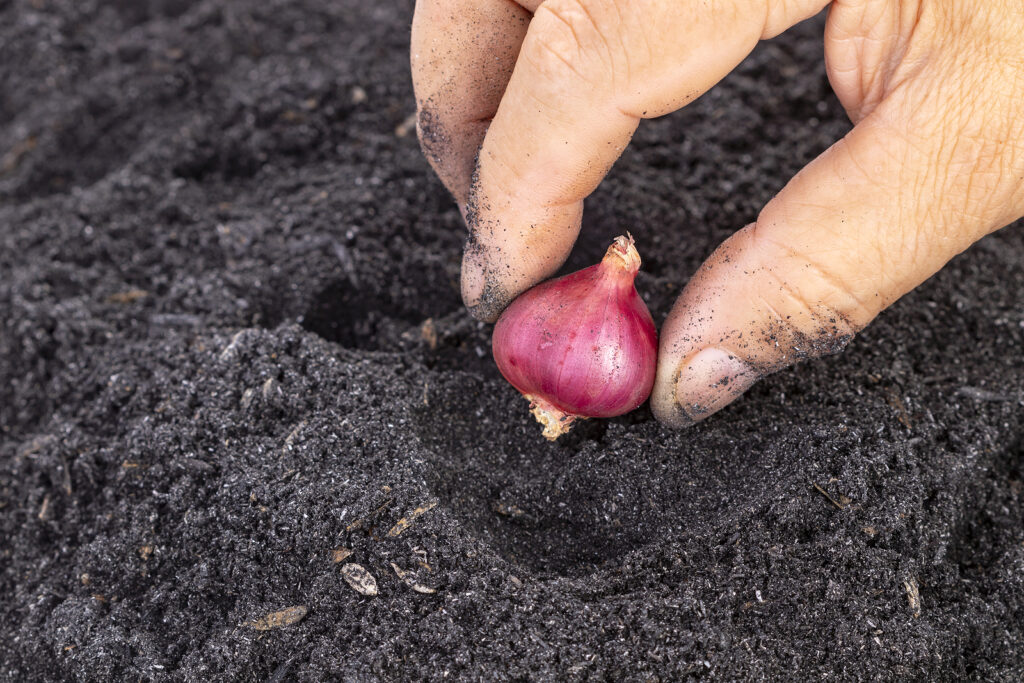
Shallot propagation
- Shallots usually do not produce seeds; they are commonly propagated by planting individual bulbs which multiply into a cluster of 8 to 12 bulbs.
- Set aside healthy, firm small to medium size bulbs at harvest for planting and growing on the following spring.
- Start with a purchased “set” of bulbs; a 1-pound set will grow 5 to 7 pounds of shallots. Save a portion of each crop to replant the following season.
Shallot varieties to grow
- ‘Ambition’: 100 days to harvest; red skin with purple flesh, globe shape; easy to grow from seed.
- Davidor’ grows to 3 inches in diameter from seed; Dutch type.
- ”
- ‘Giant Red’: early sprouts; stores well through winter and spring; for salads and cooking; 100 days to maturity.
- ‘French Epicurean’: for spring or fall planting; mild onion flavor; stores in the garden over winter; 100 days to maturity.
- ‘French Gray’: 100 days to harvest; pear-shaped bulb, grayish-blue skin with purple flesh; subtle flavor; does not store well—eat fresh.
- ‘French Red’: sweet-pungent flavor; reddish skin and flesh; 2-inch bulbs; 120 days to maturity.
- ‘Giant Red’: mildly spicy; 105 days to maturity.
- ‘Matador’: 90 days to harvest; round (French type), red-brown skin with reddish flesh; blot resistant and is long storing.
- ‘Yellow Multiplier’: most popular variety; stores well; 100 days to maturity.
- More Varieties: ‘Atlantic’ (90 days); ‘Atlas’ (90 days); ‘Dutch Yellow’ (90 days); ‘French Shallots’ (90 days); ‘Frog Leg Shallots’ (90 days); ‘Giant Red’ (70 days); ‘Golden Gourmet’ (77 days); ‘Grey Shallot’ (90 days); ‘Odetta’s White Shallot’ (90 days); ‘Pink Shallots’ (90 days); ‘Success’ (90 days).
Shallots frequently asked questions
Q: How should I treat shallots when they are growing?
A: Tend shallots as you would onions. Harvest them after their tops die down in summer. Dry them in the sun for a few days, and then store them in a cool, dark, dry place.
About shallots
- Common name: Shallot
- Botanical name: Allium cepa and Allium ascalonicum and Allium cepa var. aggregatum and Allium oschaninii
- Family: Amaryllidaceae — onion family; other members of the family include leeks, scallions, chives, ramps, onions, multiplier onions
- Description: Shallot plants grow about 8 inches tall in a clump with narrow green leaves; they look much like small onions. The roots are shallow and fibrous and the bulbs are about a half inch in diameter when mature. The bulbs grow in a “nest” of 3 to 15 bulbs; they resemble a head of garlic cloves except there are fewer cloves and no outer covering, unlike garlic.
- Origin: South and Central Asia
Onion articles at Harvest to Table:
How to Grow Green Onions, Spring Onions, and Scallions
Growing Onion Bulbs: Pick the Right Variety for Your Garden
How to Plant, Grow, and Harvest Welsh Onions
How to Harvest and Store Onions
Onion Family Growing Problems: Troubleshooting
Onion Cooking and Serving Tips
Tasty Ways to Cook and Serve Shallots
How to Make Onion Soup with No Recipe
How to Plant, Grow, and Harvest Shallots
English Peas, Spring Onions and Roasted Almonds
Tropea Onion – The Red Torpedo
Grow 80 vegetables: KITCHEN GARDEN GROWERS’ GUIDE
Garden Planning Books at Amazon:
- Vegetable Garden Grower’s Guide
- Tomato Grower’s Answer Book
- Vegetable Garden Almanac & Planner
- Kitchen Garden Grower’s Guide Vegetable Encyclopedia
More how to grow articles:
Learn how to plant, grow, and harvest your favorite vegetables. Click below for all you need to know.
- Artichoke
- Arugula
- Asparagus
- Beans, Snap
- Beets
- Broad Beans
- Broccoli
- Brussels Sprouts
- Cabbage
- Cantaloupe — Melons
- Cardoon
- Carrots
- Cauliflower
- Celeriac
- Celery
- Chard
- Chayote Squash
- Chickpeas
- Chicory
- Chinese Cabbage
- Collards
- Corn Salad
- Corn, Sweet
- Cresses
- Cucumbers
- Eggplant
- Endive and Escarole
- Fava Beans
- Florence Fennel
- Garbanzo Beans
- Garlic
- Horseradish
- Jerusalem Artichoke
- Kale
- Kohlrabi
- Leeks
- Lettuce
- Lima Beans
- Melons
- Mizuna
- Mustard Greens
- New Zealand Spinach
- Okra
- Onions
- Parsnips
- Peanuts
- Peas
- Peppers
- Potatoes
- Pumpkins
- Radicchio
- Radishes
- Rhubarb
- Rutabaga
- Salsify
- Shallots
- Sorrel
- Southern Peas
- Soybeans
- Spinach
- Squash, Summer
- Squash, Winter
- Sunchokes
- Sweet Potato
- Swiss Chard
- Taro
- Tomatillo
- Tomatoes
- Turnips
- Watermelon
- Zucchini



